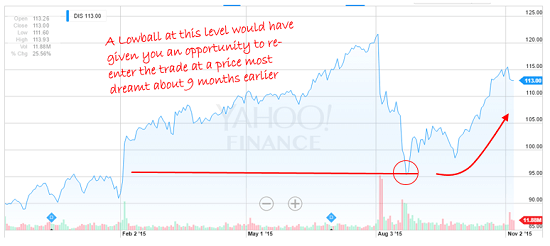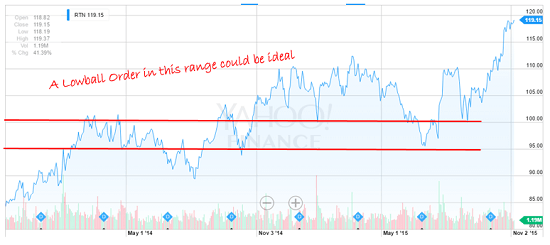I'm often asked during presentations around the world for my favorite money-making tip, and without fail I come back to the same one every time.
It's one of the simplest, yet most powerful wealth-building tactics available to individual investors today.
Plus, it's a great equalizer. It lets you take away the advantage normally enjoyed by Wall Street's biggest, most ruthless traders. And, in the process, buy the stocks you want at exactly the price you want to pay.
We've talked about this tactic before. But now, with the markets dancing around new highs and the Fed making noises about a rate hike in December, I think it's a great time to revisit the subject.
I believe you will be thrilled by how easy it is to use, especially when you understand that you don't have to sit in front of your computer screen all day to bank the kind of profit potential most people only dream about.
In short, it'll help you master the markets. Let's get started...
Lowball Orders: Effective and Simple
The tactic I'm talking about is the lowball order.
There are three reasons to love it:
- You can place lowball orders in advance.
- You don't have to be at your computer to lock in profit potential.
- You control risk by buying only when the stocks you want are trading at exactly the price you want to pay.
Lowball orders are technically "limit" orders. That's Wall Street-speak for an order to buy or sell shares at a specific price or better. Unlike "market" orders, which go into effect the moment you place them, limit orders trigger only when prices reach the limits you've specified.
So, for example, Apple Inc. (Nasdaq: AAPL) is trading at roughly $120 a share right now, but you think $110 is what you'd like to pay. Obviously nobody knows whether the stock will drop to those levels. But that shouldn't stop you from preparing for the possibility.
The point of a lowball order is to pay the price you want. Whether that happens today, tomorrow, or six months from now is moot. To paraphrase my grandfather, who played baseball in the 1920s, you miss 100% of the swings you never take.
Lowball orders help you prepare in advance for conditions that favor your money. Placing them doesn't cost you a thing, and you're not risking one red cent until the order executes and you're off to the races.
How to Place a Lowball Order
As these four steps show, using a lowball order is pretty simple.
First, you line up with one or more of the Unstoppable Trends we're following: Technology, Medicine, War, Terrorism & Ugliness, Demographics, Scarcity/Allocation, or Energy.
Second, you select a stock that's beaten down or otherwise out of short-term alignment with long-term valuations, fundamentals, and earnings potential. Ideally, it's not just any old stock. I talk frequently about maintaining a "buy list" of companies you want to own if you get the opportunity to pick them up at a dramatic discount. To me, this is Apple at $70, Tesla at $200, or even Facebook at $60. Your list may differ; my point is that you have a list... at all times.
Third, you pick an entry price that matches your expectations, your risk, and your belief about what your intended purchase is really worth.
In most cases, lowball orders align nicely with logical "support" or previous lows that can be chosen based on the time frame you're trading. While there is no hard-and-fast rule here, many traders find being within 10% and 15% of the most recent annual low is fertile hunting in choppy markets.
And, finally, you place your order to "buy XYZ at $ or less GTC" - meaning "good till canceled."
Then you wait for prices to come to you. Why really doesn't matter. It can be an overreaction to "bad" news, a sector pullback, a down day in the market, China, Putin's latest move, or anything else that causes emotional angst.
What you're hoping to catch is exactly the type of unusually large market move that crushed so many investors on Aug. 24 when the Dow plunged 1,000 points. Your goal is to buy at levels others believe are "impossibly low" at a time when your competition is not thinking clearly.
Now, what I am talking about is NOT market timing.
Lowball orders are very carefully planned "profit-traps" that are laid out in advance. You set them in place to take advantage of conditions that favor you as opposed to the institutional traders who normally dominate the markets and whose express goal is to separate you from your money.
Let's look at a few examples.
Walt Disney Co. (NYSE: DIS) took off on a furious run last January, leaving anybody not on board in the dust. On Aug. 25, the stock tumbled to $90 a share. On Nov. 2, it closed at $113 for a quick 25.55% gain.
The same day, Apple fell to $92 a share. It closed Nov. 2 at $120.92 for a 31.43% gain.
[mmpazkzone name="in-story" network="9794" site="307044" id="137008" type="4"]
 There were dozens of high-quality stocks that got shellacked on Aug. 25, and every single one of them was ripe for profits on the rebound... but only if you were prepared to act.
There were dozens of high-quality stocks that got shellacked on Aug. 25, and every single one of them was ripe for profits on the rebound... but only if you were prepared to act.
Limit orders do have some limitations worth noting, though.
For example, there is no guarantee that a limit order will execute if there is too much price movement or prices blow past the limit or never reach it to begin with. In other words, a limit order guarantees the price you specify "or better," but not necessarily that your order gets executed.
That used to be a big deal back when floor traders did most of the trading, markets lacked the liquidity they have today, and spreads were quoted in fractions. But now volume is much higher and spreads are in decimals. There's also computerization, which has heavily influenced order flow.
Depending on how sophisticated you want to be, you can tack on special instructions. Most commonly that's things like the "GTC," which stands for "good till cancelled," as I've already mentioned. Others include "GTD," which means "good to a specific date" you pick, or "AON," which means "all or none," as in the trader has to fill all the shares requested in a single trade.
Here's a Lowball Order You Can Use Right Now
Raytheon Co. (NYSE: RTN) has proven to be a fantastic recommendation for Money Map Report subscribers for good reason. Subscribers who are following along as directed in the Money Map Report have had the opportunity to capture gains of at least 100% and are now sitting on total returns of 177%.
Folks ask me all the time if they can "get on board" with the trade because Raytheon still has so much potential. In a word, "yes" - but not by chasing performance.
Buy low, sell high is the path to profits.
What you want to do is pick up shares of Raytheon at a discount, then sit back and let everybody else who actually does chase performance do the dirty work for you.
In looking at the Raytheon chart, it's apparent the stock goes in spurts. That means it's tailor-made for lowball orders because prices periodically drop to key support levels that give fresh money a terrific opportunity to push prices higher (again).
A price of $95 to $100 per share looks pretty appealing because that's where traders have duked it out earlier this year, and for much of 2014, too.
So, for example, assuming you want to buy 100 shares at $95, the lowball order you'll want to put in play with your broker or your favorite online trading platform would read as follows:
Buy to open 100 shares of RTN limit $95 GTC.
- That's "buy" because you're buying shares.
- "To open" because you're initiating the trade.
- "100 shares" because that's what you want to own.
- "RTN" because that's Raytheon's ticker symbol.
- "Limit $95" because that's what you want to pay and not a penny more.
- "GTC" meaning good till you cancel the order or it's executed.
At the end of the day, it doesn't really matter whether you are placing lowball orders as an investor or as a day trader. Your goal is the same - to profitably harness quick swings that drive most investors straight to the poorhouse.
Lowball orders work because every great company gets put on sale periodically for reasons that have nothing to do with the business case for owning them: Visa, Google, Apple, and Gilead, just to name a few. There are no exceptions.
That's why it makes great sense to line up your share of profits ahead of time, then wait for everybody else to panic and bring the prices to you on your terms.
And just when is that going to happen?
I think the Fed's December rate hike is a good candidate.
Follow us on Twitter @moneymorning.
Editor's Note: Keith Fitz-Gerald regularly finds today's most promising investments by looking for those that have "Unstoppable Trends" working for them. In fact, Keith's pick to play the Unstoppable Trend of Human Augmentation has returned more than double the S&P 500 in the year since he recommended it - and he sees even more dramatic outperformance of the markets in the company's near future. For a free report on the tiny robotics company poised to conquer an industry doubling every year through 2021, sign up for Total Wealth here - it's free!
About the Author
Keith is a seasoned market analyst and professional trader with more than 37 years of global experience. He is one of very few experts to correctly see both the dot.bomb crisis and the ongoing financial crisis coming ahead of time - and one of even fewer to help millions of investors around the world successfully navigate them both. Forbes hailed him as a "Market Visionary." He is a regular on FOX Business News and Yahoo! Finance, and his observations have been featured in Bloomberg, The Wall Street Journal, WIRED, and MarketWatch. Keith previously led The Money Map Report, Money Map's flagship newsletter, as Chief Investment Strategist, from 20007 to 2020. Keith holds a BS in management and finance from Skidmore College and an MS in international finance (with a focus on Japanese business science) from Chaminade University. He regularly travels the world in search of investment opportunities others don't yet see or understand.



